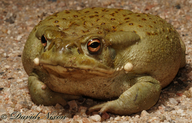|
Description
Adults are usually large, stout-bodied toads, 110-187 mm long from snout to vent. Their olive skin is smooth, leathery, and scattered with small rounded tubercles often set in rust colored spots. Behind the angle of the jaws there is at least one conspicuous white tubercle. The length of each paratoid gland is twice the paratoid width, and equal to the distance from the nostril to the tympanum. On the dorsal surfaces of the limbs there are several enlarged glands that resemble the paratoids. Above each eye curves a distinct cranial crest.
Distribution and Habitat
Country distribution from AmphibiaWeb's database: Mexico, United States U.S. state distribution from AmphibiaWeb's database: Arizona, California, New Mexico
Found from southern Arizona(USA), through most of Sonora to northern Sinaloa (Mexico). Its range extends into the southeastern parts of California, USA and the northeastern corner of Baja California, Mexico. These toads are primarily found in the desert, but also occur in grassland and low elevation oak-woodland. They frequently take refuge in rodent burrows. Though they often breed in temporary pools, they appear to be dependant on the presence of a permanent water source.
Life History, Abundance, Activity, and Special Behaviors
Primarily nocturnal.
These toads appear in Tuscon just prior to the summer showers, and congregate once the rains begin. They breed in temporary pools, croaking incessantly. Males have a reduced vocal sac and their call is weak. Their tadpoles are strikingly different from those of related species Bufo boreas and B. canorus, being gray or golden brown. The larval period is believed to be no more than a month. Their diet includes beetles, grasshoppers, spiders, small lizards, Bufo cognatus and Scaphiopus couchi.
Trends and Threats
Habitat destruction and possibly pesticide use have caused populations to become extinct. Collecting by certain groups is also a threat to populations in some areas. In California, populations occur along the Colorado River, which have been severely depleted. It is listed as a State Species of Special Concern (CA DFW 2019).
Relation to Humans
The glands of the toads produce a toxin (5-methoxy-N,N-dimethyltryptamine or 5-MeO-DMT) that can cause hallucinations in humans, and therefore is a controlled substance. Possible reasons for amphibian decline Drainage of habitat
Local pesticides, fertilizers, and pollutants
Comments
This species was featured as News of the Week on 24 February 2020:
Smoking the dried secretions from toads is known for its psychedelic effects and recent investigations indicate it may alleviate depression, anxiety, and symptoms of PTSD. Uthaug et al. (2019) sought to determine the sub-acute and long-term therapeutic applications of the dried toxins from the Colorado River Toad Incilius alvarius, which has high concentrations of the psychoactive compound 5-methoxy-N,N-dimethyltryptamine (or 5-MeO-DMT). The authors implemented a series of questionnaires before and after (up to 24-hour and again at 4-weeks post) a single inhalation of the substance in a naturalistic setting. Participants were more satisfied with their lives and had improved mental states immediately after their experience and these feelings were still present at the 4-week survey. Depression and anxiety decreased to a significant degree 4-weeks post exposure. Clearly investigations into 5-MeO-DMT for its therapeutic benefits continue to show promise.
References
Fouquette, M. J., Jr (1963). ''Bufo alvarius.'' Catalogue of American Amphibians and Reptiles. American Society of Ichthyologists and Herpetologists, 93.1-93.4.
Originally submitted by: April Robinson, Michelle Koo (first posted 2001-01-29)
Edited by: Arie van der Meijden, Vance T. Vredenburg (2022-07-20)Species Account Citation: AmphibiaWeb 2022 Incilius alvarius: Sonoran Desert Toad <https://amphibiaweb.org/species/97> University of California, Berkeley, CA, USA. Accessed May 28, 2025.
Feedback or comments about this page.
Citation: AmphibiaWeb. 2025. <https://amphibiaweb.org> University of California, Berkeley, CA, USA. Accessed 28 May 2025.
AmphibiaWeb's policy on data use.
|
